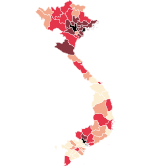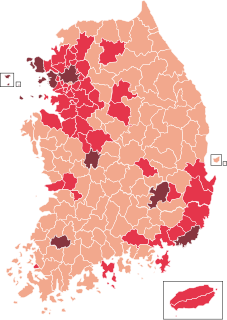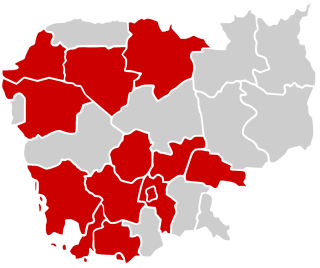The following lists events that happened during 2020 in the Republic of Singapore.

Severe acute respiratory syndrome coronavirus 2 (SARS-CoV-2) is the virus strain that causes coronavirus disease 2019 (COVID-19), a respiratory illness. Colloquially known as the coronavirus, it was previously referred to by its provisional name 2019 novel coronavirus (2019-nCoV). SARS-CoV-2 is a positive-sense single-stranded RNA virus. It is contagious in humans, and the World Health Organization (WHO) has designated the ongoing pandemic of COVID-19 a Public Health Emergency of International Concern.

This article documents the chronology and epidemiology of the severe acute respiratory syndrome coronavirus 2 (SARS-CoV-2), the virus responsible for the 2019–20 coronavirus pandemic, which was first detected in Wuhan, China. Some developments may become known or fully understood only in retrospect.

This article documents the February 2020 chronology and epidemiology of SARS-CoV-2, the virus responsible for the 2019–20 coronavirus pandemic which originated in Wuhan, China in December 2019. Some developments may become known or fully understood only in retrospect.

The presence of coronavirus disease 2019 (COVID-19) in Malaysia, part of the 2019–20 coronavirus pandemic, was first reported in January 2020 when it was detected on travellers from China arriving via Singapore on 25 January, following the outbreak of COVID-19 in Hubei, China. Reported cases remained relatively low and were largely confined to imported cases, until localised clusters began to emerge in March; the largest cluster was linked to a Tablighi Jamaat religious gathering held in Sri Petaling, Kuala Lumpur in late February and early March, leading to massive spikes in local cases and an exportation of cases to neighbouring countries. Within a few weeks, Malaysia had recorded the largest cumulative number of confirmed COVID-19 infections in Southeast Asia, breaching over the 2,000 mark in active cases by the end of March from fewer than 30 at the start of the month. By 16 March, the virus is reported in every state and federal territory in the country.

An outbreak of coronavirus disease 2019 (COVID-19), part of the 2019–2020 global pandemic, has been ongoing in Thailand since 13 January 2020, when the country made the first confirmation of a case outside China. Surveillance among incoming travellers revealed a small number of cases throughout January, almost all of whom were visitors or residents returning from China. The first reported local transmission was confirmed on 31 January. The number of cases remained low throughout February, with forty confirmed by the end of the month. Cases saw a sharp increase in mid-March, which was attributed to several transmission clusters, the largest of which occurred at a Muay Thai fight at the Lumpinee Boxing Stadium on 6 March. Confirmed cases rose to over a hundred per day over the following week, and public venues and businesses were ordered to close in Bangkok and several other provinces. Prime Minister Prayut Chan-o-cha declared a state of emergency, effective on 26 March. A curfew has been announced, effective since night of 3 April 2020.

The ongoing pandemic of coronavirus disease 2019, a novel infectious disease caused by severe acute respiratory syndrome coronavirus 2, spread to Vietnam on 23 January 2020, when its first known case of COVID-19 was reported. As of 3 May 2020 the country had 271 confirmed cases, 219 recoveries, and no deaths. More than 261,000 tests have been performed. Hanoi is currently the most-affected city with 112 confirmed cases.

The ongoing pandemic of coronavirus disease 2019, a novel infectious disease caused by severe acute respiratory syndrome coronavirus 2, spread to South Korea on 20 January 2020, when the first case was announced. The number of confirmed cases increased on 19 February by 20, and on 20 February by 58 or 70, giving a total of 346 confirmed cases on 21 February 2020, according to the Centers for Disease Control and Prevention Korea (KCDC), with the sudden jump mostly attributed to "Patient 31" who participated in a gathering at a Shincheonji Church of Jesus the Temple of the Tabernacle of the Testimony church in Daegu.

The ongoing pandemic of coronavirus disease 2019, a novel infectious disease caused by severe acute respiratory syndrome coronavirus 2, soon spread to Hong Kong, and the first confirmed case was announced on 23 January 2020. Confirmed cases are generally transferred to Princess Margaret Hospital's Infectious Disease Centre for isolation and centralised treatment. On 5 February, only after a 4-day strike by front line medical workers did the Hong Kong government close all but three border control points – Hong Kong International Airport, Shenzhen Bay Control Point, and Hong Kong-Zhuhai-Macao Bridge Control Point remaining open. As of 25 April 2020, Hong Kong had 1,036 confirmed cases, 753 recovered cases and four death cases.

The pandemic of coronavirus disease 2019 (COVID-19) has had a more moderate impact in Taiwan than in many neighboring countries, with six deaths total as of 30 April 2020. The number of active cases peaked on 6 April at 307 cases.

The 2019–20 coronavirus pandemic began in Asia in Wuhan, Hubei, China, and has spread widely through the continent. As of 2 May 2020, at least one case of COVID-19 had been reported in every country in Asia except North Korea and Turkmenistan.

This article documents the chronology and epidemiology of SARS-CoV-2 during March 2020. This is the virus responsible for the 2019–20 coronavirus pandemic, which originated in Wuhan, China in December 2019. Some developments may become known or fully understood only in retrospect. Reporting on this outbreak began in December 2019.

This article documents the chronology and epidemiology of SARS-CoV-2 in April 2020, the virus responsible for the 2019–20 coronavirus pandemic which originated in Wuhan, Hubei, mainland China. Some developments may become known or fully understood only in retrospect.
The first case of the COVID-19 disease caused by the SARS-CoV-2 virus in Qatar was confirmed on 27 February 2020. As of May 2, Qatar has the 2nd highest number of confirmed cases in the Arab World at 14,872. The total recoveries stand at 1,534, with 12 deaths.

The first case of the pandemic of coronavirus disease 2019 (COVID-19) was confirmed in Cambodia on 27 January 2020. According to Global Health Security Index's report in 2019, Cambodia ranked 89th out of 195 countries in preparedness for infectious disease outbreak.

National responses to the 2019–20 coronavirus pandemic have been varied, and have included containment measures such as lockdowns, quarantines, and curfews. As of late April, there are 2.9 million cases of COVID-19 and over 203,800 deaths in 210 countries and territories around the world. The most affected countries in terms of confirmed cases being the United States, Spain, Italy, France, Germany, the United Kingdom, Turkey and China.

The 2019–20 coronavirus pandemic was first confirmed to have spread to England with two cases among Chinese nationals staying in a hotel in York on 31 January 2020. The two main public bodies responsible for health in England are NHS England and Public Health England. NHS England oversees the budget, planning, delivery and day-to-day operation of the commissioning side of the NHS in England while PHE's mission is "to protect and improve the nation’s health and to address inequalities".

This article documents the chronology of the response to the 2019–20 coronavirus pandemic in March 2020, which originated in Wuhan, China in December 2019. Some developments may become known or fully understood only in retrospect. Reporting on this outbreak began in December 2019.

This article documents the chronology of the response to the 2019–20 coronavirus pandemic in February 2020, which originated in Wuhan, China in December 2019. Some developments may become known or fully understood only in retrospect. Reporting on this outbreak began in December 2019.
















